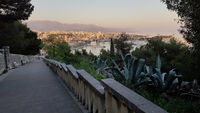Marjan Park in Split - Croatia: Difference between revisions
Jump to navigation
Jump to search
| Line 43: | Line 43: | ||
== Which challenges is this landscape facing?== | == Which challenges is this landscape facing?== | ||
*'' | *''Since the reforestation efforts were done before much was known about the ecology of a forest, many of the trees were planted too close to each other. Consequently, there is too much shade on the forest floor and not enought room for new trees to grow and continue the forest's life cycle. Another challenge is that mostly monocultures were planted over the entire hill (there are only a few different types of trees on Marjan). The potential of the hill as a habitat for many different species is enormous, because the hill has many different micro-climates and differing make-ups of the soil. For instance the southern side is sunny, steep with deep fertile soil. The northern side is often in the shade and has shallow, less fertile soil. '' | ||
== What would be your strategy for improvement?== | == What would be your strategy for improvement?== | ||
Revision as of 21:25, 18 December 2018
>>>Back to Case Studies Overview
>>>Marian Park Forest
| Marjan Park Forest | add the site name | |
| Split | add the city name | |
| Croatia | add the country | |
| Stanislava Odrljin | add your name(s), optional | |
| World Heritage | if applicable,enter the year of listing | |
|
[[File:LED_PARK FOREST MARJAN_ASSIGNMENT 1_ODRLJIN_STANISLAVA_1] | ||
|
| ||
Why is this case relevant?
- The hill Marjan has had an interesting history of being a natural area that was devastated and re-naturalized by the citizens of Split. Because its history is so long, it is a very interesting case study in the relationship of people to nature within a town. Marjan has been a backdrop in the city’s vista from its beginnings. Prehistoric people lived in the oak forest on Marjan, as did solitary monks. For a period of time it was protected by Venetians and later exploited for timber. For many years it was a barren hill, until aristocrats decided to reforest it to serve as hunting grounds. During the socialist period, reforestation was an organized voluntary activity for groups of young people. Today, the result of this reforesting is an aged pine forest that is everyone’s favorite place to spend the weekend. Its cultural value comes from these layers of history which tell its story. Also fascinating is the future of the forest. The fact that it was re-forested almost a hundred years ago means that the trees are now very old, soon it will be time to introduce young trees and plants. The method and choices used, along with better knowledge of botany and ecology today can completely shape this space into a rich, new city commons in which the history of people intervening in nature can be continued in a positive way.
Which idea of ‘design with nature’ guides the design concept of this site?
- This forest is completely man-made in that almost all the trees were planted in the 18th-20th centuries. The hill, once abundant with oak trees, was exploited during the decline of the Venetian Empire. In the 18th century the agricultural and “Marijan” societies begin reforesting the hill with Aleppo Pines (Pinus halepensis). In the 20th century, animals were brought there and the entire hill was enclosed by a fence and served as a hunting ground. The animals (pheasants, deer, rabbits, turkeys) were cared for by both the hunters and the Marjan society. Pigeon houses were made for pigeons and a botanical garden was built on the southern slopes. The relationship toward nature is by today’s standards perhaps cruel (hunting), but in the context of the time, these initiatives show a curious interest of the city’s citizens in reviving the wilderness of the hill. The hill was not beautified, manicured or especially planned. Rather, it was aggressively forested - trees were even planted too close to each other. All of this gives the hill a very natural, even wild atmosphere. Today, one would never know it was artificially reforested. Today, such an undertaking would be in stride with the times, but two-hundred years ago, it must have been quite unique. One of the most interesting aspects of Marjan's history was the the reforestation was the sum of many grass-roots initiatives (from hunters to socialist youth groups). The park was not planned by the city nor by a wealthy aristocrat.
Which challenges is this landscape facing?
- Since the reforestation efforts were done before much was known about the ecology of a forest, many of the trees were planted too close to each other. Consequently, there is too much shade on the forest floor and not enought room for new trees to grow and continue the forest's life cycle. Another challenge is that mostly monocultures were planted over the entire hill (there are only a few different types of trees on Marjan). The potential of the hill as a habitat for many different species is enormous, because the hill has many different micro-climates and differing make-ups of the soil. For instance the southern side is sunny, steep with deep fertile soil. The northern side is often in the shade and has shallow, less fertile soil.
What would be your strategy for improvement?
Finally, please share some ideas of how you would initiate positive change for your heritage area
Image Gallery
- Yourimage.jpg
your image text and source
- Yourimage.jpg
your image text and source
References
- Author Year: Title, publisher, edition, page, ...
- etc.
- Website Year: Link, keyword, ...
- etc.












